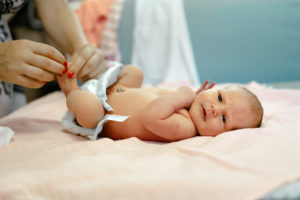What Are the Different Kinds of Diapers?
If you’ve decided that cloth diapers are the best choice for your child, then you’ll need to find something that is highly absorbent and completely waterproof.
Usually, the most flexible and economic cloth diapering solution comes in two separate pieces, with each piece having its function.
While the shapes can be similar, it’s the type of fabric material that differentiates between a diaper and cover.
You have the option of trying out different types of diapers. Some parents may choose to use a specific type depending on their preferences, so it’s an individual choice.
In a cloth diaper system, the most absorbent part is generally called the diaper, with the two most common styles being prefold and fitted diapers.
Most diapers are made of cotton. However, other highly absorbent materials like bamboo, hemp, and synthetic microfiber are also commonly used.
Prefold Diapers:
Prefold diapers are some of the most popular cloth diapers and have been around for many decades. In addition to being a popular option among many parents, they are also the least expensive and can be easily adjusted to ensure a comfortable fit.
Prefolds are absorbent fabric in the rectangular form that is folded and in some cases, fastened to fit the baby.
There are infant size prefolds that are suitable for infants weighing up to 15 lbs and premium sizes used for children weighing over 15lbs.
Standard size prefolds are the same size as premium, only that they feature fewer layers
Fitted Diapers:
Fitted diapers are designed to ensure a perfect and secure fit and usually have snaps, hook, or loop fasteners.
They generally don’t require folding and are therefore considered easy to use. One of their biggest benefits is their ability to contain the messes well, especially with infants.
They typically come in sizes from newborn to toddler
Diaper Covers:
Also referred to as a cover, wrap, or soaker, a diaper cover is the waterproof outer piece that is made from different materials like polyester, nylon, or wool.
You’ll also find vinyl covers, which are basically “rubber pants” meant to act as diaper covers.
However, you’ll want to avoid these because they are cheaply made and are not as breathable as the above-mentioned materials.
The waterproof property of a diaper cover helps protect clothing, car seats, furniture, stroller, and other items from possible leakage.
If you’re indoors throughout the day, you can always skip using a diaper cover for breathability and extra comfort. It’s good to let the skin breathe every once in a while.
Diaper covers also have fasteners like snap, hook, and loop and are available in sizes from newborn to toddler
All-in-One Diaper:
All-in-one diapers have this unique style that has the absorbent piece of material attached to the waterproof material.
This eliminates the need to use a separate cover. All-in-one diapers are super easy to use, but can be quite expensive and also take more time to dry completely.
Pocket Diapers:
Pocket diapers have a style that is characterized by a two-layer cover and the absorbent diaper piece is added to a pocket opening, hence the name.
Once all the pieces are assembled, a pocket diaper is used as an all-in-one diaper.
Other diaper styles include flats (which are traditional single layer squares), contour diapers (a blend of fitted and prefold), and hybrid pocket/aio.
How Many Diapers Do You Need Per Day?
Newborn babies need a regular diaper change and may thus use more diapers per day. Typically, a newborn may require at least 12 or more diapers.
Older babies may use between 6-9 diapers every day.
In this case, you’ll probably require at least 24 diapers, making sure you’re washing the dirty ones every day. If you don’t use cloth diapers full-time, 12 diapers are enough.
If you have a setup where the diaper and cover are separate, you can purchase 4-6 covers as they will be reused for countless diaper changes.

As a mother of four very energetic children, Emilia knows how chaotic motherhood can be. She’s learned a lot of lessons along the journey so far and loves sharing the tips & tricks she’s picked up over the years with anybody else on the same life path.

